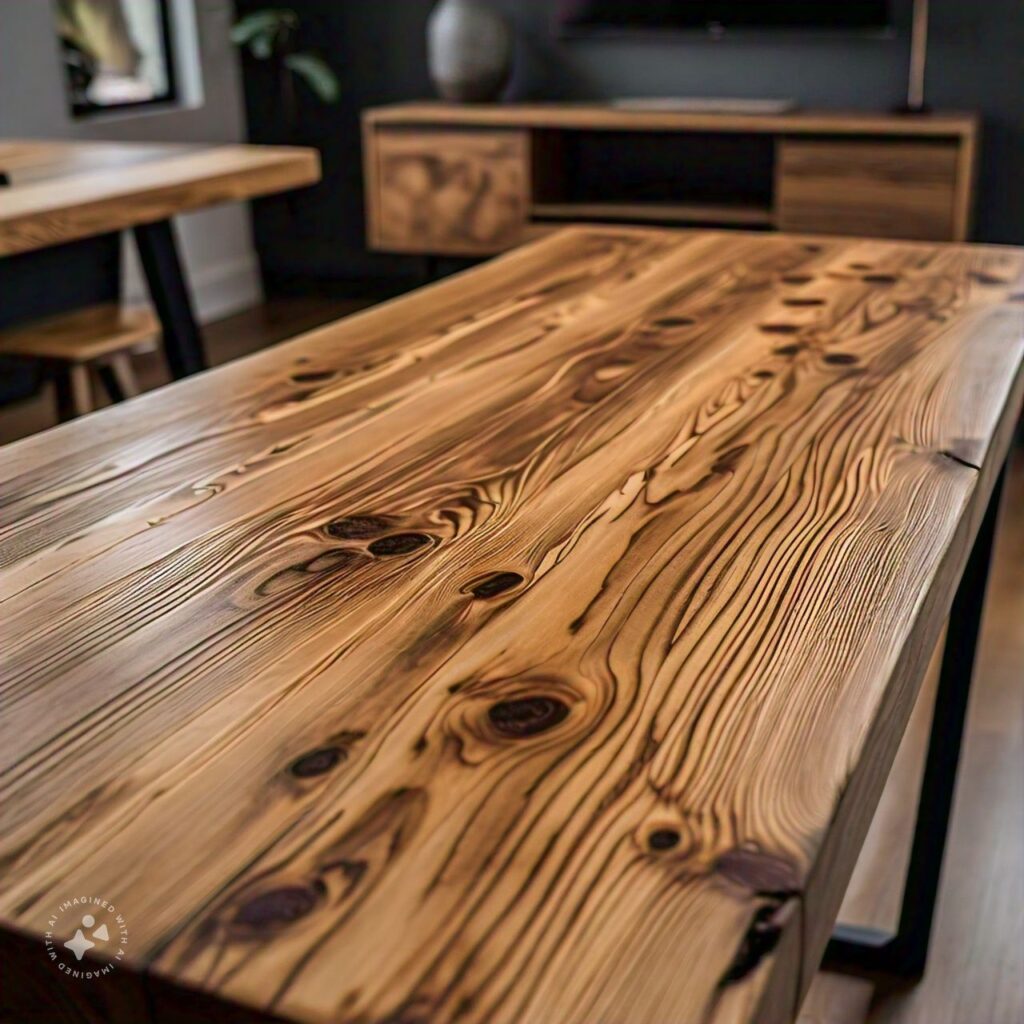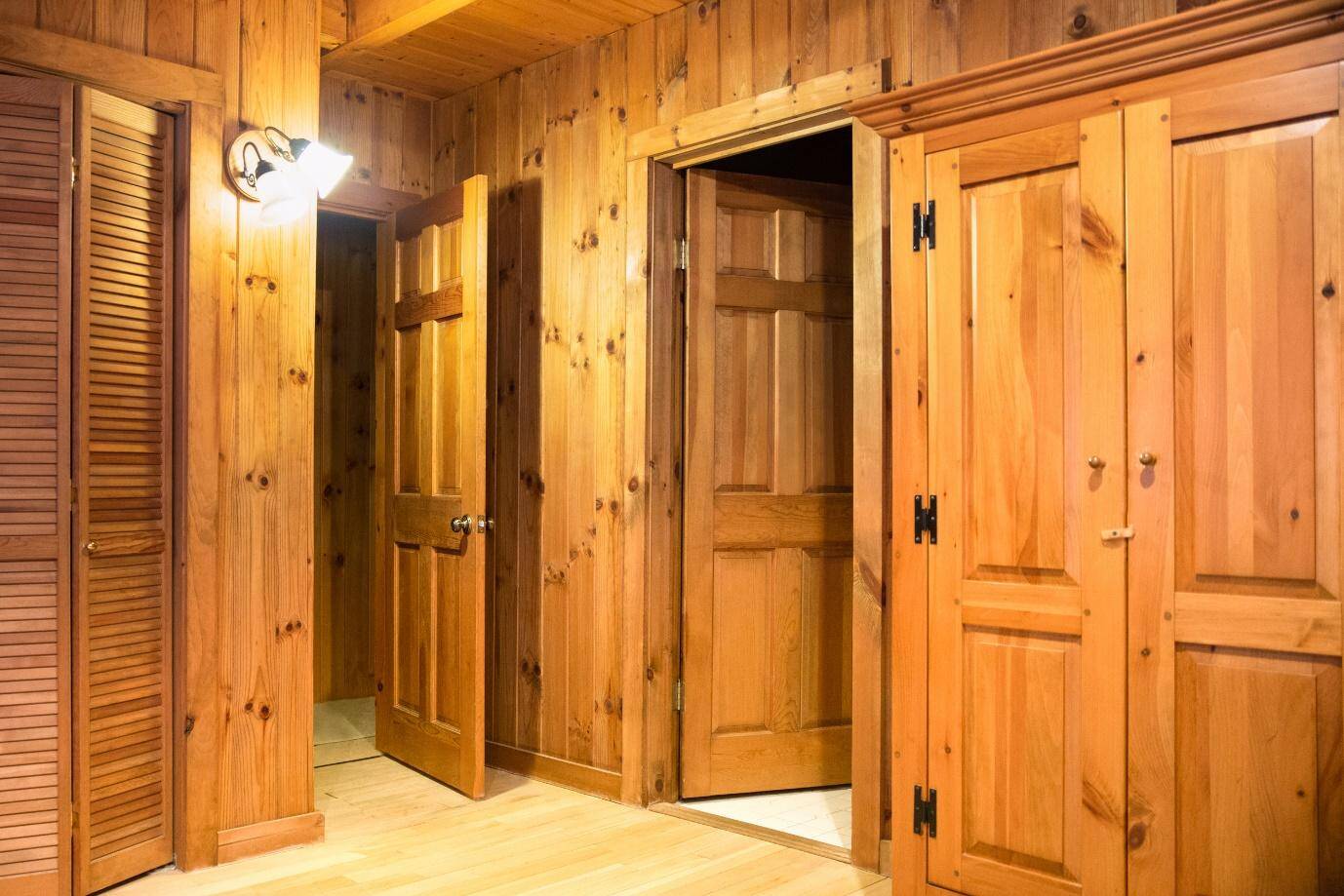Knotty pine is a softwood often used for decorative finishes in the home, such as furniture, wall paneling, window edges, doorframes, and trim. It’s a popular choice for most households because of its natural orange-honey color, fine texture, straight grain, and small, tight knots that are easy to cut around.
Often considered a beautiful wood for the home, knotty pine was initially used to style homes in the 40s, 50s, and 60s. For this reason, it can be considered outdated or dull for the modern home. However, in recent years, knotty pine paneling has become a trend for modern house interiors.
Highly flexible and versatile, knotty pine paneling can be painted, stained, or varnished in any color. You don’t need to tear down knotty pine paneling from the wall or ceiling, nor do you need to replace the kitchen cabinets. Refinishing the pine paneling can be significantly cheaper and offer better value in the long term.
Keep reading to discover why knotty pine paneling and cabinets are suitable for the home, and learn how to make knotty pine look modern.
Is Knotty Pine Good Wood?
Yes, knotty pine has long been considered a good wood for residential settings. It’s strong, durable, lightweight, and boasts a stunning natural color. Because of its even texture and light appearance, it’s highly versatile and can be used for almost anything around the home. It’s also easy to paint, stain, cut, and shape into almost any design, including a tongue-and-groove system.
Some of the benefits of using knotty pine are that it’s:
- Inexpensive and widely available
- Easy to cut, plane, sand, style, and finish
- Sturdy, long-lasting, and easy to maintain
- Highly adaptable (it can be used indoors or outdoors, provided it’s suitably treated)
However, knotty pine has some downsides. Firstly, its appearance isn’t always considered desirable, and it can be difficult to pair with modern appliances and furniture.
For this reason, knotty pine paneling on walls and ceilings is popular in log cabins to create warmth, coziness, and a country vibe. However, the traditional orange-hue style can be considered dated in the average home. Knotty pine furniture can be styled with any interior, including log cabins, modern homes, or modern-rustic home décors.
The actual wood is knotty, which means it has dark or light notches across each panel. These are difficult to hide when staining but can be covered up if you’re painting the product. Despite the tight and near unbreakable knots when cutting, the appearance isn’t as clean as some other types of wood finishes, like clear pine.
Finally, even though knotty pine is strong, it isn’t as durable as other, more complex, denser types of wood. It’s also not very resistant to water or moisture and needs to be correctly sealed around the edges to make it waterproof.

Is Knotty Pine Wood Expensive?
Knotty pine is generally considered inexpensive, no matter where it’s purchased. Compared with other types of wood, like oak, spruce, cedar, or ash, pine grows quickly and is, therefore, more widely available than most other wood finishes.
According to How Much Is It USA, knotty pine paneling prices can range between $2 (for a 1×4 inch panel) and $6 (for a 2×8 inch) panel. The exact costs of knotty pine plywood can vary depending on the size of the panel, type of panel (tongue and groove or plywood sheets), wood thickness, and how much wood you purchase. It also varies depending on the finish.
Most pine is knotty because pine trees have many branches spawning from their trunks. These knotholes make the wood paneling beautiful and unique, but you can choose pine without knotholes or with minimal knots. Pine plywood or boards without knots are rarer and, therefore, more expensive.
All wood paneling, including knotty pine plywood, has a grade ranging from A to D. Each plywood grade offers a different strength and finish. Under the direction of the American Lumber Standard Committee, there are five types of pine lumber: select, joint, appearance, construction, and stud.
Select-grade pine lumber is graded C and D (with grade C being the highest quality) and is most frequently used for woodworking projects, tongue-and-groove pine paneling, interior paneling, and cabinets. Because it has a stronger, nicer finish than some of the other types of pine, it can be more expensive.
Despite its low installation cost (compared with other types of wood), knotty pine paneling can be valuable for specific properties. Wall paneling, particularly modern wainscotting or board and batten, is often considered a desirable, contemporary aesthetic. Knotty pine paneling can be considered outdated in some homes, but can add value to a log cabin, country home, or modern house (when the paneling is styled correctly).
How Long Does Knotty Pine Last?
Knotty pine paneling can last a lifetime when properly cared for. Generally, you can expect knotty pine paneling, wood products, or cabinets to last 10-50 years. However, like most wood, there isn’t a time limit on how long knotty pine will last. Depending on the surrounding environment, it could last forever when well-maintained or just a few years.
Knotty pine paneling on exterior walls, sheds, or outhouses isn’t generally recommended over other wood types. Even pressure-treated knotty pine won’t last as long as other wood when used outdoors. It can rot over time, get dented or scratched during adverse weather, and warp when exposed to sunlight for prolonged periods (like over several years).

How Do You Modernize Knotty Pine Cabinets or Walls?
Knotty pine cabinets, with their light orange hue and clean finish, are natural beauties. However, their aesthetic isn’t always considered suitable for a modern home interior. Naturally, their style often best suits a rustic decor or log cabin home. However, it’s easy to modernize knotty pine cabinets or change their appearance to suit any color scheme.
- Apply a Different Stain
Knotty pine kitchen cabinets, bathroom vanities, and paneling are usually stained with an orange or dark wood stain to protect the exterior and add sheen. If you like the appearance of the natural wood in your home but don’t like the color, you can remove the existing stain and apply a different paint. Applying a grey wood stain or lightening the wood are popular choices to modernize knotty pine cabinets or walls.
To remove the existing stain, you can either use a wood stripper or lightly sand the wood until the stain is removed (although sanding will take longer than a stripper). Oil-based products are the best stains for pine, as they soak into the wood better and provide a more long-lasting finish. Learn more about how to stain wood nicely.
- Repaint
Because it has a smooth, clean finish, knotty pine is easy to paint. If you want to completely change the color of your knotty pine kitchen cabinets, or want to create a bright window frame, you can paint them any color using high-quality wood paint. When you paint knotty pine, you can remove the paint and restore it to its natural wood later.
Oil-based paint is the best choice for knotty pine, as it offers a better sheen. However, oil-based paints are often higher in VOCs (Volatile Organic Compounds), which makes them more hazardous to the air and environment.
It’s usually best to use semi-gloss or high-gloss paint for wooden furniture and cabinets, as these will offer protection and shine while being easy to clean. When painting cabinets and wall panels, you’ll usually need to give them 1-2 coats of paint.
- Change the Hardware
Changing the hardware on your knotty pine kitchen cabinets can make a massive difference to their overall appearance. Swap the hardware for something more modern, like a sleek pull handle or contemporary chrome knob. Or, to make the project more affordable, you can restore your old hardware to make it appear bright, shiny, and like new.
- Attach Wood Trim
Another idea to modernize knotty pine cabinets is to attach sleek modern trim around the edges of the doors and drawers or in a pattern around the front, side, or top of the cabinet. Attaching wood trim to a cabinet is relatively straightforward, especially if you want to create a board-and-batten style for the front of your cabinets.
- Add Decals
A quick, modern, affordable, and temporary way to modernize knotty pine cabinets is to cover them up with peel-and-stick decals. You can find finishings in faux marble, grained wood, sleek block colors, or floral patterns.
Covering your cabinets, worksurfaces, wall panels, or bathroom vanities with these decals is simple and can be done in a day without significant preparation. This is an excellent choice if you don’t enjoy DIY or the cabinets are fixtures in a rental and cannot be permanently changed.
What Colors Compliment Knotty Pine?
Because knotty pine is generally light and natural in its appearance, it’s often best to pair the wood with neutral tones. However, the color that works best for your house depends on the overall vibe you want to achieve.
For example, a log cabin in the country may benefit from a warm, rustic accent, like yellow, orange, brown, purple, or red. A modern interior will benefit from a lighter character, like white, beige, taupe, sage green, country blue, or a pastel color.
Generally, knotty pine paneling, especially groove pine paneling on walls, ceilings, or windows, is best paired with lighter colors to brighten the room overall. Meanwhile, knotty pine cabinets can be paired with any color scheme.
How Do You Brighten Up a Knotty Pine Wall?
Knotty pine paneling on walls or a ceiling can appear dark, dull, and outdated. Because knotty pine wood is easy to re-finish, you can quickly change its overall appearance by:
- Painting the wood a lighter color, like white, beige, or a pastel color
- Applying a light wood stain, like a grey stain
- Applying a lighter varnish
- Sanding the wood to restore its natural, light pine color
- Accessorizing with bright features, like wall art, pictures, lights, or surrounding furniture




